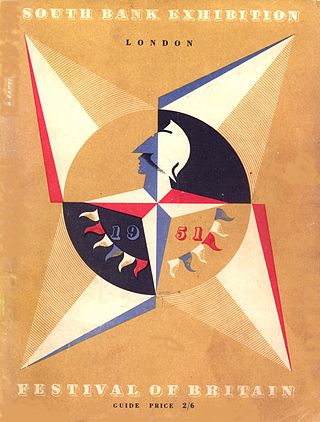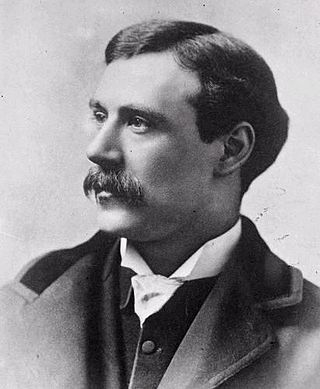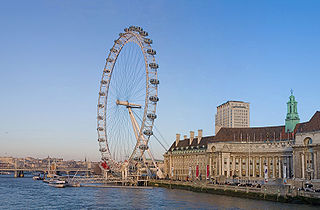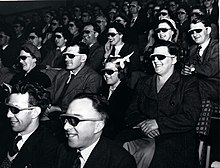
The Festival of Britain was a national exhibition and fair that reached millions of visitors throughout the United Kingdom in the summer of 1951.

William Friese-Greene was a prolific English inventor and professional photographer. He was known as a pioneer in the field of motion pictures, having devised a series of cameras between 1888–1891 and shot moving pictures with them in London. He went on to patent an early two-colour filming process in 1905. Wealth came with inventions in printing, including phototypesetting and a method of printing without ink, and from a chain of photographic studios. However, Friese-Greene spent all his money on inventing, went bankrupt three times, was jailed once, and died in poverty.

The National Science and Media Museum, located in Bradford, West Yorkshire, is part of the national Science Museum Group in the UK. The museum has seven floors of galleries with permanent exhibitions focusing on photography, television, animation, videogaming, the Internet and the scientific principles behind light and colour. It also hosts temporary exhibitions and maintains a collection of 3.5 million pieces in its research facility.

The South Bank is an entertainment and commercial district in central London, England on the south bank of the River Thames opposite the City of Westminster. It forms a narrow strip of riverside land within the London Borough of Lambeth and the London Borough of Southwark,. As such, the South Bank may be regarded as somewhat akin to the riverside part of an area known previously as Lambeth Marsh and North Lambeth.
3D films are motion pictures made to give an illusion of three-dimensional solidity, usually with the help of special glasses worn by viewers. They have existed in some form since 1915, but had been largely relegated to a niche in the motion picture industry because of the costly hardware and processes required to produce and display a 3D film, and the lack of a standardized format for all segments of the entertainment business. Nonetheless, 3D films were prominently featured in the 1950s in American cinema, and later experienced a worldwide resurgence in the 1980s and 1990s driven by IMAX high-end theaters and Disney-themed venues. 3D films became increasingly successful throughout the 2000s, peaking with the success of 3D presentations of Avatar in December 2009, after which 3D films again decreased in popularity. Certain directors have also taken more experimental approaches to 3D filmmaking, most notably celebrated auteur Jean-Luc Godard in his film Goodbye to Language.

The Odeon Luxe Leicester Square is a prominent cinema building in the West End of London. Built in the Art Deco style and completed in 1937, the building has been continually altered in response to developments in cinema technology, and was the first Dolby Cinema in the United Kingdom.

The Odeon Luxe West End is a two-screen cinema on the south side of Leicester Square, London. It has historically been used for smaller film premieres and hosting the annual BFI London Film Festival. The site is on an adjacent side of the square to the much larger flagship Odeon Luxe Leicester Square.
The year 1951 in architecture involved some significant events.

The British Film Institute (BFI) is a film and television charitable organisation which promotes and preserves film-making and television in the United Kingdom. The BFI uses funds provided by the National Lottery to encourage film production, distribution, and education. It is sponsored by the Department for Culture, Media and Sport, and partially funded under the British Film Institute Act 1949.

Wells Wintemute Coates was an architect, designer and writer. He was, for most of his life, an expatriate Canadian who is best known for his work in England, the most notable of which is the Modernist block of flats known as the Isokon building in Hampstead, London.

Southbank Centre is a complex of artistic venues in London, England, on the South Bank of the River Thames.

The BFI IMAX is an IMAX cinema in the South Bank district of London, just north of Waterloo station. It is owned and operated by the British Film Institute. From 2012 until 2022, it had been operated by Odeon Cinemas.

The Museum of the Moving Image is a media museum located in a former building of the historic Astoria Studios, in the Astoria neighborhood in Queens, New York City. The museum originally opened in 1988 as the American Museum of the Moving Image, and in 1996, opened its permanent exhibition, "Behind the Screen," designed by Ali Höcek of AC Höcek Architecture LLC. The museum began a $67 million expansion in March 2008 and reopened in January 2011. The expansion was designed by architect Thomas Leeser.

The Museum of the Moving Image (MOMI) was a museum of the history of cinema technology and media sited below Waterloo Bridge in London. It was opened on 15 September 1988 by Prince Charles and at the time, was the world's largest museum devoted entirely to cinema and television. The museum formed part of the cultural complex on the South Bank of the River Thames. MOMI was mainly funded by private subscription and operated by the British Film Institute. MOMI was closed in 1999, initially on a supposedly temporary basis, and with the intention of its being relocated to Jubilee Gardens nearby. Its permanent closure was announced in 2002.

Waterloo Road is the main road in the Waterloo district of London, England straddling the boroughs of Lambeth and Southwark. It runs between Westminster Bridge Road close to St George's Circus at the south-east end and Waterloo Bridge across the River Thames towards London's West End district at the north-west end.

The BFI London Film Festival is an annual film festival held in London, England in collaboration with the British Film Institute. The festival runs for two weeks in October every year. In 2016, the BFI estimated that around 240 feature films and 150 short films from more than 70 countries are screened at the festival each year.

BFI Southbank is the leading repertory cinema in the UK, specialising in seasons of classic, independent and non-English language films.

The Hayward Gallery is an art gallery within the Southbank Centre in central London, England and part of an area of major arts venues on the South Bank of the River Thames. It is sited adjacent to the other Southbank Centre buildings and also the National Theatre and BFI Southbank repertory cinema. Following a rebranding of the South Bank Centre to Southbank Centre in early 2007, the Hayward Gallery was known as the Hayward until early 2011.
The BFI Production Board (1964-2000) was a state-funded film production fund managed by the British Film Institute (BFI) and "explicitly charged with backing work by new and uncommercial filmmakers." Emerging from the Experimental Film Fund, the BFI Production Board was a major source of funding for experimental, art house, animation, short and documentary cinema, with a continuing commitment to funding under-represented voices in filmmaking.

James Scott is a British filmmaker, painter, draughtsman and printmaker.

















